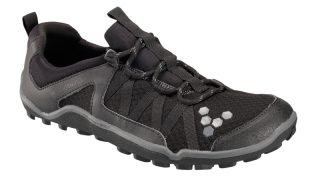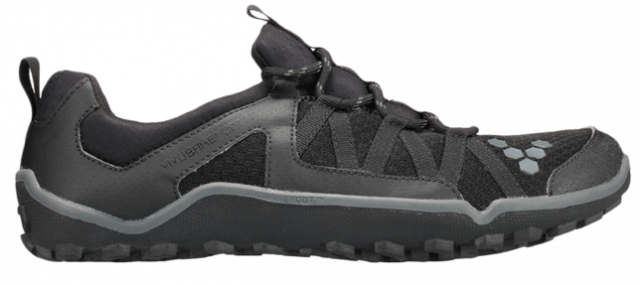
VIVOBAREFOOT Breatho Trail
Size Tested: 10.5
Shoe Weight: 285g
Stack: +7mm toe and heel (add +3mm with the midsole cushion)
Reviewer’s Brannok Shoe Size: 11D
Reviewer’s Foot Length: 278mm
Reviewer’s Typical Shoes: Brooks sz 10.5, New Balance sz 11, Hoka sz 11, Merrel sz 11, Salomon sz 11
Days Tested: 7
Locations Tested: Wasatch Mountains, Utah
The entire range of VIVOBAREFOOT (aka Vivo) shoes is, as you might have guessed, zero drop, barefoot-style shoes.
Vivo distinguishes itself by building trail shoes with much taller and more aggressive outsole lugs than most barefoot style shoes on the market, such as the Altra Adam, Merrell Trail Glove, and Vibram Five Finger.
Fit / Sizing
I found the length of the Breatho Trail at size 10.5 to fit me nicely. I have about a half-thumb of space in front of my toes, the ball of my foot lines up with the flex zones on the sole of the shoe, and the wide point of my metatarsal heads line up with the wide points of the shoe.
The Vivo is a pretty high-volume shoe in width around the ankle and height at the instep. I had to use the 3mm midsole and add an old insole from a running shoe to keep my foot from sliding forward in the shoe when running. That said, I would stick with the sizing since I don’t have any space in the toebox to downsize.
The Breatho Trail also has a pretty unorthodox heel pocket—it’s nearly vertical. Most shoes arch forward significantly to create a perch for the top of your calcaneus bone, which prevents upward heel lift while you’re power-walking uphill. No matter what I did with lacing, socks, or the addition of the extra insole, I couldn’t prevent heel lift in this shoe.
I didn’t really notice any issue with heel lift while I was running or walking downhill, but it was mildly annoying while walking or recovering. While I haven’t had any issues with blisters on short runs (under 5 miles), I think if I were to run about 15 miles, I’d tell a different story. But since my knees and right ankle can’t run farther in barefoot shoes at this point anyway, this isn’t a deal-breaker for me. Of course, not all feet are the same, so your experience may well vary.
Upper
The upper of the shoe is made out of a nice stretchy neoprene-type material, which, as the shoe’s name implies, makes for a well-ventilated sneaker.
The upper is slipper style: there is no tongue and the upper is closed. There is, however, a strange stitch-line that runs all the way around the throat of the shoe that prevents the throat from stretching, even though the material itself is very stretchy. I had a very difficult time getting my foot into the shoe due to this stitch line.
The lacing system seems adequate, though I found myself wishing for another eyelet higher up and closer to my instep to help keep my foot back in the heel pocket.

Weight
The Breatho Trail is a fairly heavy shoe for the barefoot category, though it’s still pretty light when compared against the spectrum of trail running footwear. It’s certainly in-line with some of the “reduced” shoes on the market. The Breatho Trail weighs 285g with the +3mm cushion insert. In the same size, the Merrell Trail Glove weighs 211g, a Salomon S-lab Sense weighs 224g, and a New Balance MT110 weighs 235g. The more heavily cushioned Brooks Pure Grit comes in at 285g (the Pure Grit 2 is 308g).
Given the slightly heavier overall weight, the Breatho Trail didn’t feel any heavier or more sluggish on trail than say, the Merrell Trail Glove. And I would gladly take the 70g weight difference for the Breatho Trail’s improved grip—I could simply propel myself forward much more effectively.
Outsole
Vivo builds their shoes with a “bathtub” design, meaning the outsole is wrapped up around the foot. To allow smooth flex in the forefoot, there are pie-cuts on either side at the met-heads that allow the shoe to flex cleanly.
The bathtub design gives the shoe just a touch more structure than Merrell’s Trail Glove, something I really appreciated. The Trail Glove punishes you for even one mid-foot strike on a small pebble, while the Breatho Trail offers a shade more protection.
The outsole features a very aggressive, grippy tread pattern. It is, as far as I know, the most aggressive tread pattern on a minimal / barefoot-style shoe, and is in-line with shoes such as a Saucony Peregrine or Brooks Cascadia. It’s pretty impressive, really.

The outsole material is fairly hard and stiff, which penetrates well into soft trail surfaces, and doesn’t squirm on very hard trail surfaces. The cost of this is the shoe’s performance on wet or smooth rocks, when it becomes downright terrifying. The outsole has a molded rock guard under the instep, which gives the runner a little more confidence on technical side edges that call for “setting an edge” with the downhill foot.
I found the the Breatho Trail to strike a good balance between trail feel and protection. Trail feel is a bit more muted than in a Merrell, which is fine in my book, as I found the Trail Glove to punish the most mild misstep in rocky terrain.
A Few Further Comparisons
Given the robust outsole of the Vivo, I think it’s splitting hairs to get too much into the difference between this shoe and shoes such as the New Balance MT110 and Salomon Sense Ultra. They are different for sure, but all in a shades-of-grey sense. The New Balance MT110 is a forefoot only shoe, while the Breatho Trail is, in my experience, a touch less punishing of a mid-foot stride. The Sense Ultra is a bit more “all-around” in terms of grip on a variety of terrain, protection, foot strikes, and sensitivity. Both the Salomon and the New Balance shoes have a good bit more rebound and response than the Vivo, but that comes at the cost of mildly increased bending resistance. The Vivo bends markedly better than the NB MT110 and mildly better than the Salomon Sense Ultra.
Caveats and Qualifications
First, an important note on my particular running style: my 200 lbs. frame, combined with a blown-up ankle and bad knees, may mean that I will never be a strong (or even capable) descender in steep, rocky terrain while wearing barefoot shoes, at least for more than a few miles. Currently, I’m not capable of running more than 4-5 miles in barefoot style shoes before my right ankle tires and can’t absorb forefoot strikes, which leads to knee pain and hip issues from overcompensating. So with those important qualifications stated, on to my experience running with the Breatho Trail.
Ascending
Of all the shoes I have run in over the last year, the Vivo is the most rewarding of “proper” running form while climbing steep trails (e.g. driving the knees high and coming straight down onto the forefoot). It’s tough to describe, but the shoe just feels right. But if I’d let my knee-drive flag and begin to accentuate heel-kick, the Breatho Trail would let me know pretty quickly that I was deviating—albeit in a less painful way than the Merrell Trail Glove would.
I can’t single out the low stack height, the very flexible toe-box, or the precise location of the flex in the forefoot to the met-heads, so perhaps it’s the blending of all these factors into a cohesive package that makes this shoe so rewarding.
Descending
When descending in the Breatho Trail, I was able to keep a short but rapid cadence, with my feet just barely skimming above the ground to minimize the impact of the step. With this style, I feel the Vivo descends markedly better than the Merrell Trail Glove, which I have to walk downhill in on the same trails.
I am quite sure a more accomplished and/or less beat up runner would humble me beyond words—regardless of the shoe—but hopefully my experience here will allow you to draw some conclusions of how well the Breatho Trail might work for you.
Bottom Line
I found the Vivo Breatho Tail to be a solid barefoot shoe that ought to work well for many folks, provided the fit jives. I would strongly suggest (more so here than normal) trying before buying.
I would love to see a more aggressive heel pocket and the use of welded seams and lighter materials in the upper, but I can live without these details given how I’m personally using the shoe.
If I still lived in a land of rolling hills and nice soil, I could easily see this being an everyday type shoe. But given my beat body and the steep rocky terrain I run on here in the Wasatch, using this shoe more than once a week on longer runs is just not in the cards, at least for now.
